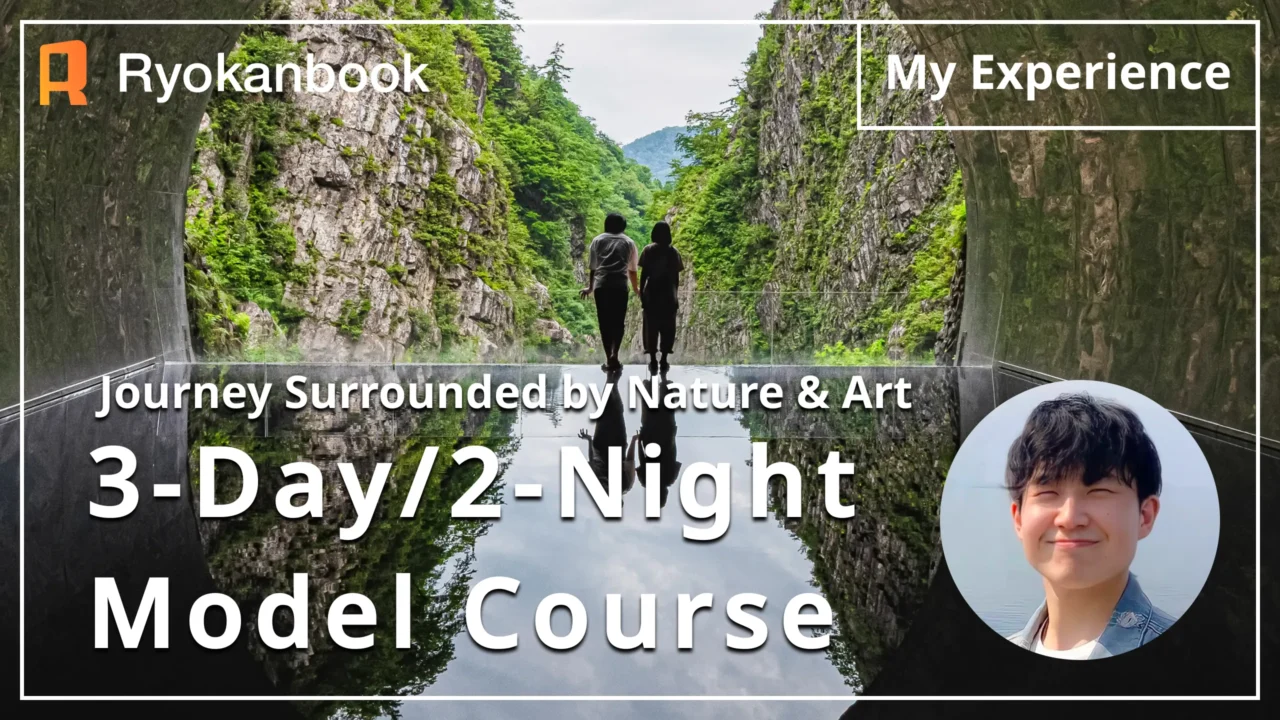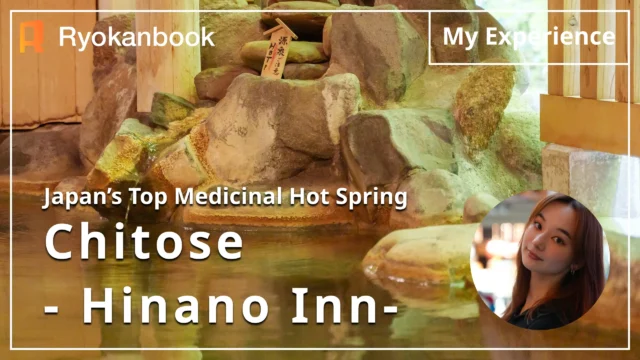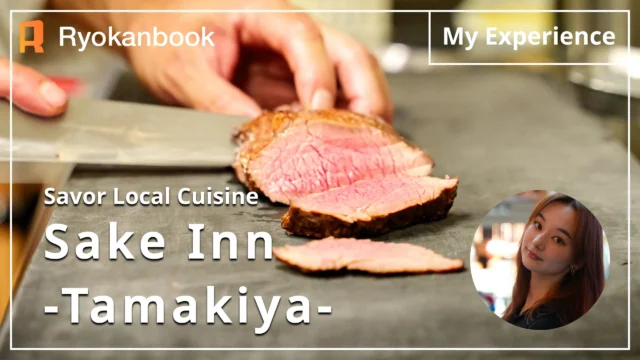It was the height of summer when I first visited this place.
The sun beat down relentlessly, yet somehow it felt comforting. The breeze was cool, the greenery deep, cicadas buzzed in the distance, and a small stream murmured nearby.
The lively sounds of summer turned into a quiet symphony here.
Tokamachi, Niigata — a town shaped by snow, water, and art.
In winter, it is buried under heavy snowfall, and when the snow melts in spring, the land slowly breathes back to life.
From this natural cycle emerged another identity: a place where art gently weaves itself into everyday living.
Symbolizing this spirit is the Echigo-Tsumari Art Triennale, one of the world’s largest regional art festivals, where artworks are scattered throughout the satoyama landscape, wrapping the entire town in creativity.
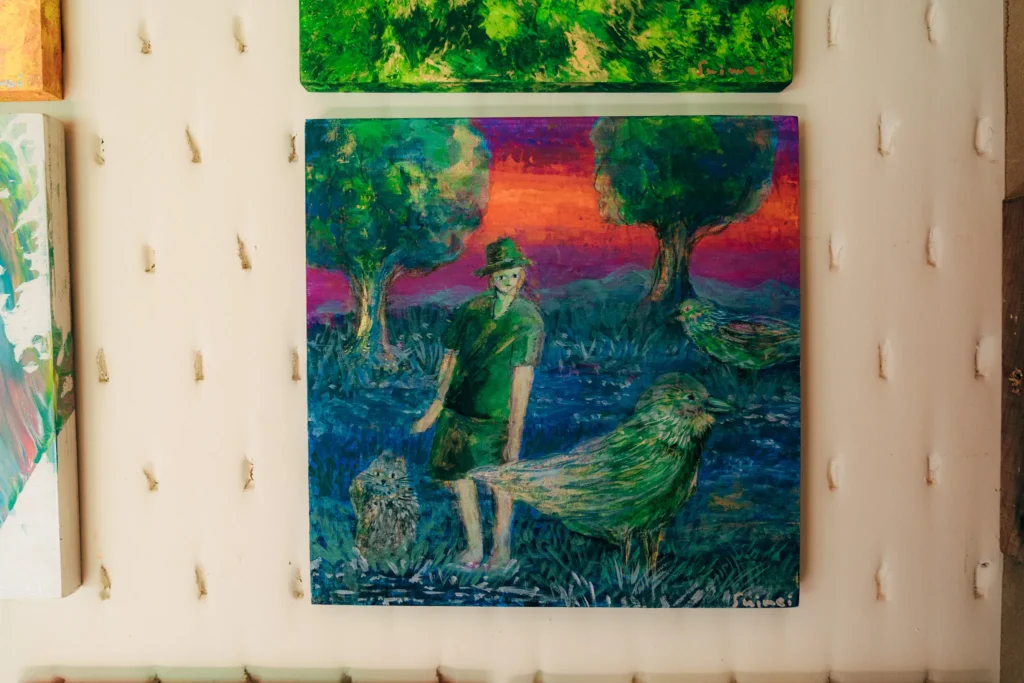
In this article, I’d like to share a three-day itinerary based on my own walk through Tokamachi, for those planning to visit.
It’s a journey where you can feel the beauty of nature, the warmth of the people, and the quiet overlap between art and daily life.By the end of your trip, you’ll likely notice the richness that lives within its stillness.

Kensuke Matsuyamaー Ken of the World
Ken launched the social media channel “Ken / Solo Japanese Style” after living in Poland, sharing content that connects Poland and Japan. He now creates videos focusing on Japanese culture and everyday Japanese life, reaching a total of one million followers. He also runs “Japan of Japan” a channel introducing traditional inns and hidden local spots across the country, with over 60,000 YouTube subscribers. Through a distinctly Japanese perspective, he showcases the authentic charm of Japan beyond its major cities to audiences around the world.
Day 1|Beginning a Journey Through Art Rooted in the Land
From Tokyo Station, it takes about two hours by Shinkansen.
Transfer to a local line at Echigo-Yuzawa, and after roughly forty minutes you’ll arrive at Tokamachi Station.(Note: IC cards aren’t accepted on this section, so carrying some cash is helpful.)
Once you arrive, renting a car at the Toyota Rent-a-Car in front of the station is the most convenient option.With many artworks scattered across the surrounding countryside, having a car makes exploring smoother.
That said, if you’re confident in your stamina, you might consider renting a bicycle inside the station for your first day, and switching to a rental car from the second day onward.
Feeling the satoyama breeze on your face as you cycle will let you experience the gentle rhythm of life in this town.
Museum on Echigo-Tsumari: Contemporary Art Rooted in the Satoyama Landscape
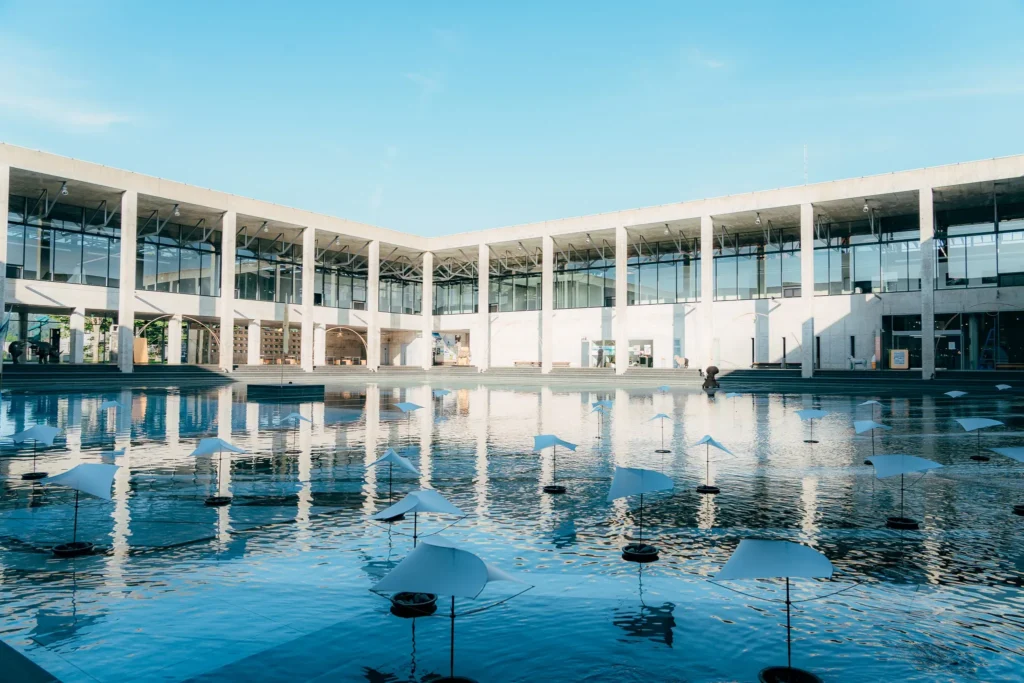
The first place to visit on Day 1 is Museum on Echigo-Tsumari, located just a ten-minute walk from Tokamachi Station.
Designed by architect Hiroshi Hara, the building features a large reflecting pool at its center, mirroring the sky and clouds above.
Whenever the wind passes through, ripples dance across the surface, as if time itself is being shaped.
Stepping inside, your senses are quietly awakened—by sound, by light, by color.
Each exhibit draws inspiration from the satoyama landscape and local ways of life, expressing art that has grown naturally from this land and the people who inhabit it.

What struck me most was an installation made of everyday household items suspended from the ceiling.
At first glance they seemed to be hanging there at random, but each object was paired with a short English phrase—
a clue that invites you to imagine what might have happened to its owner.Someone’s joy, someone’s sorrow.Even without faces or video, the scenes began to take shape in my mind.It was in that moment I realized: art isn’t something that gives you answers.
It’s something that leaves room for you to imagine.

Soak in at the adjoining hot spring, Akashi no Yu, if you have time along the way.
The facility is surprisingly spacious and has a unique atmosphere—quite different from a typical Japanese onsen.
Steam drifts through its modern architectural space, making it feel almost like an extension of the art you’ve just experienced.
Even so, the baths and sauna are well equipped, and once you slip into the water, the warmth slowly reaches the core of your body.
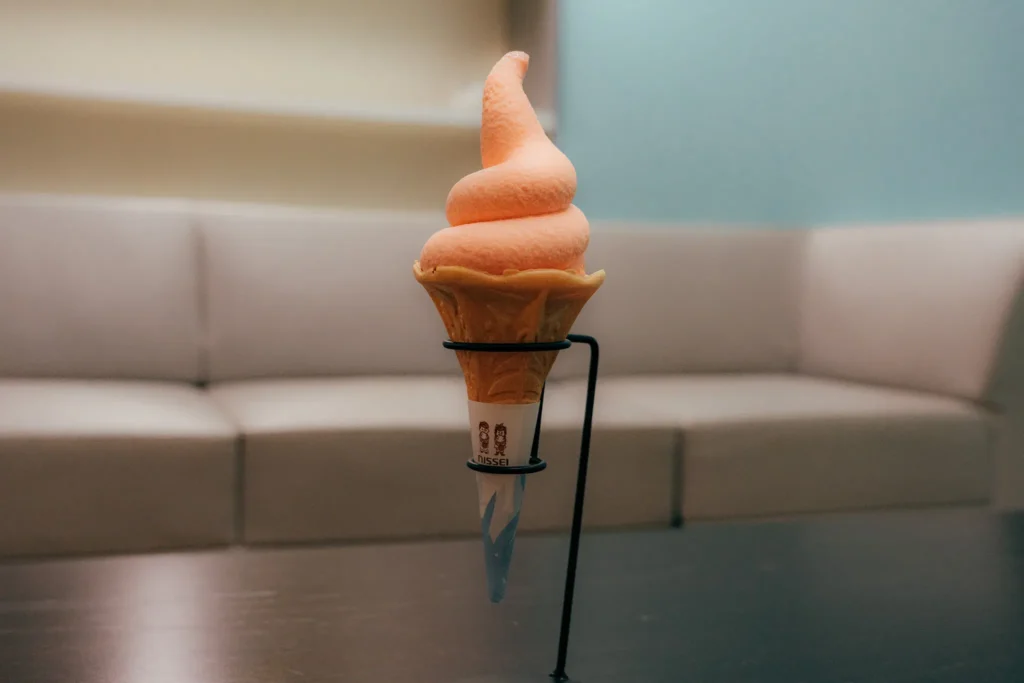
After your bath, try the local specialty: carrot ice cream.
Its gentle sweetness spreads across your palate, as if the soft air of this snowy region were quietly soaking into your body.
The Echigo-Tsumari Art Triennale — a world-renowned celebration of regional art
Next on the journey is the Echigo-Tsumari Art Triennale, the festival that Tokamachi proudly shares with the world.
Here, the entire town becomes a vast canvas, with artworks dotted across fields, villages, and mountain hamlets.
Since its launch in 2000, the festival has been shaped by the idea that “humans live within nature, not outside it.”
Artists and local residents work together to create works that grow from the land itself.
Rather than “building” tourist attractions, the festival seeks to preserve the memories of the place.
On this trip, I visited three pieces in particular—each one expressing a different face of Tokamachi and reflecting the richness held within this land.
1. Asphalt Spot — Feeling the Pulse of the Earth

The first piece worth visiting is Asphalt Spot, an artwork in which the ground itself becomes the canvas.Black asphalt undulates like waves, creating the strange sensation that gravity has been disturbed.
Standing on the piece, you feel the subtle slopes and rises beneath your feet, realizing how stable the “ordinary ground” usually is. It’s a quiet encounter with the extraordinary hidden within an everyday landscape.
2. Kagan-dan Hillside Viewpoint — A Classic Niigata Landscape Unfolds
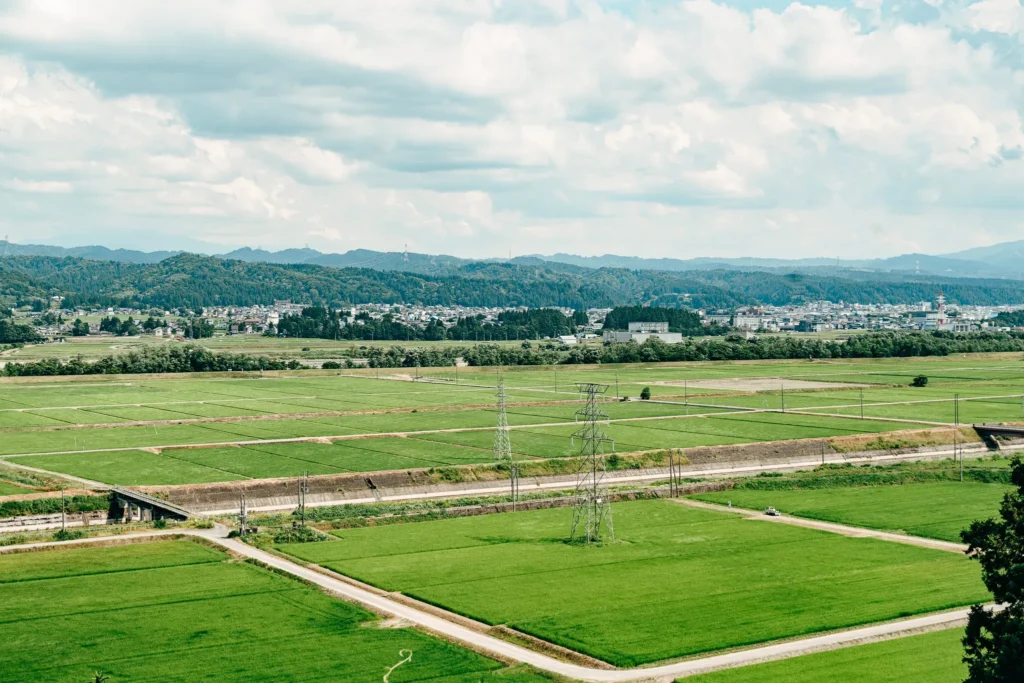
From the Asphalt Spot, it’s a 15-minute drive.Along the way, endless rice fields stretch out on both sides of the road— the quintessential scenery of Niigata.The rice plants rustle softly in the wind, and the green waves rippling across the fields are calming enough to soothe your mind just by passing through.
Cross the Tsumaari Bridge over the Shinano River, climb the hill, and suddenly the view opens wide. This is the Kagan-dan Hillside Viewpoint.Terraces carved by the Shinano River overlap with tiered rice fields, creating a three-dimensional landscape that feels like a work of art shaped by the earth itself.
With each season, the scenery shifts—sometimes vibrant, sometimes quiet—and the breeze and stillness seep gently into your heart.
3. House of Light — An Experience That Frames the Sky
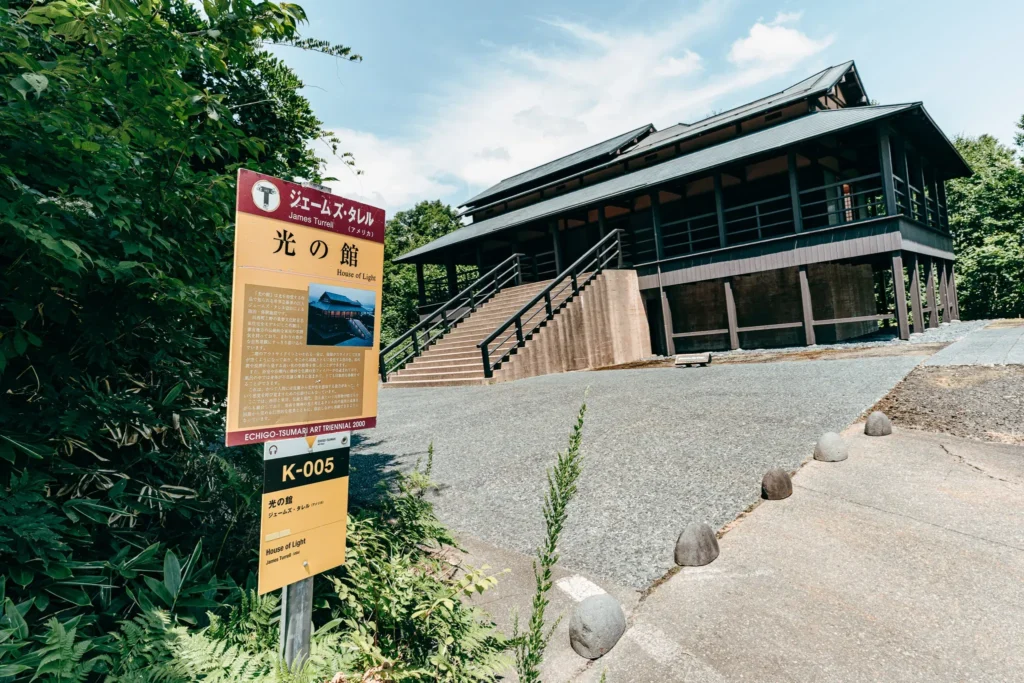
The last stop of the day is the House of Light, created by James Turrell, the American master of light.
At first glance, it appears to be a quiet wooden building, but its ceiling opens to frame the sky like a living canvas.As sunset approaches, the colors of the sky respond to the shifting lights inside, and the entire space fills with a slowly changing gradient of light.In those moments, even the passing of time becomes part of the artwork.
You can also stay overnight, spending the evening simply watching light from within the architecture.
It is a place where nature, structure, and human perception melt into one— a space that feels as if you are breathing in rhythm with the light itself.
→ For a detailed account of Echigo-Tsumari Art Triennale experience
Yukinoya — A Home That Illuminates the Memories of Snow Country

Tonight’s stay is at Yukinoya (Furusawa Residence), a beautifully restored 150-year-old kominka set along the banks of the Shinano River.
Limited to one group per night, the house offers an intimate and deeply peaceful experience.
Though it retains the quiet elegance of old Japan, the interior is remarkably clean and thoughtfully equipped with modern comforts.Next to the tatami room is a bedroom with proper beds, making it welcoming even for those unaccustomed to traditional futons.

Step through the entrance and you’re greeted by the scent of wood and the warmth of a stove.
In the living room, thick wooden beams span the open ceiling, their presence quietly expressing the depth of time they’ve witnessed.The kitchen is spacious, and guests are free to use the traditional irori hearth as well.
You can stop by a local supermarket, pick up whatever ingredients you like, and enjoy meals in your own style, at your own pace—one of the charms unique to this place.
It feels less like staying somewhere, and more like living here, even if just for a night.
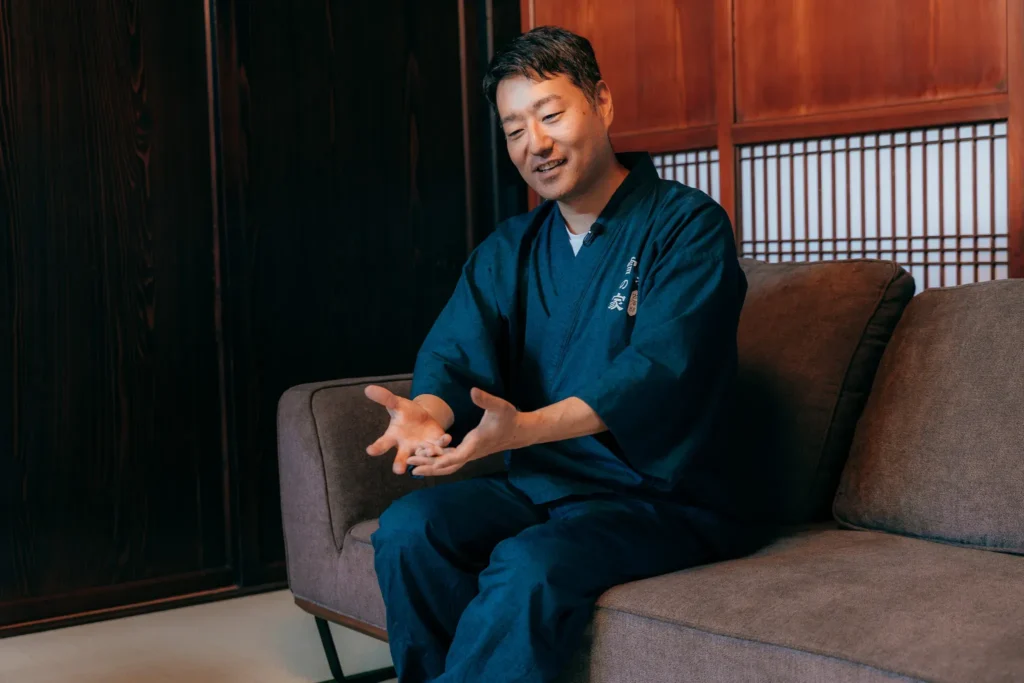
The host, Mr. Ibi spoke gently about the wisdom and culture of the snow country— the purpose of the roofed walkways called gangi, and the way houses were ingeniously designed to endure harsh winters.Everything he explained reflected the aesthetic sensibility that has taken root in this land.
At Yukinoya, the wisdom of people who learned to live alongside severe nature— their “ingenuity for living” and their “beauty in everyday life”—is still very much alive.
To bring light back into an old farmhouse where a family once laughed and lived is more than restoring a place to stay;
it is an act of carrying forward the memories of the region.
As night deepens, only the crackling of firewood and the faint whisper of wind outside remain.
This quiet, unhurried night is a luxury you can never experience in the city.

The next morning, a local mother prepares freshly cooked Koshihikari rice in the kitchen.Though it’s your first time meeting, her warmth feels strangely familiar— a gentle final touch that completes the journey.
→Read about Yukinoya-Furusawa experience here
Day 2 | A Day to Connect with Nature and Find Inner Calm
Tokamachi Terraced Rice Fields Trek — The Breathtaking Hoshitoge Course
On the morning of Day 2, the innkeeper at Yukinoya, Mr. Ibi, offers a guided experience called the Terraced Rice Fields Trek. If you have the chance, it’s well worth joining.
The meeting point is Hokuhoku Ōshima Station on the Hokuhoku Line. After a quiet prayer at a small shrine, the trek begins as you step gently into the mountains.

Mr. Ibi slowly teaches us the names of the trees, the scents of the leaves, and the workings of the mountains.
“What makes this place special,” he said, “is that both the trees and the people here live supported by the snow.” Those words left a lasting impression.
The trail follows an old, unpaved road. Beneath your feet, the soft earth cushions each step, and when you rub a branch of kuromoji between your fingers, a refreshing scent rises and drifts through the air. The wind stirs the trees, and the rustling of leaves flows like waves.
The round-trip course takes about three and a half hours. Along the way, Mr. Ibi adjusts the pace to suit our condition, allowing for occasional breaks. Some slopes are steep, but strangely, the sensation is more pleasant than exhausting, and the mountains feel surprisingly comforting.
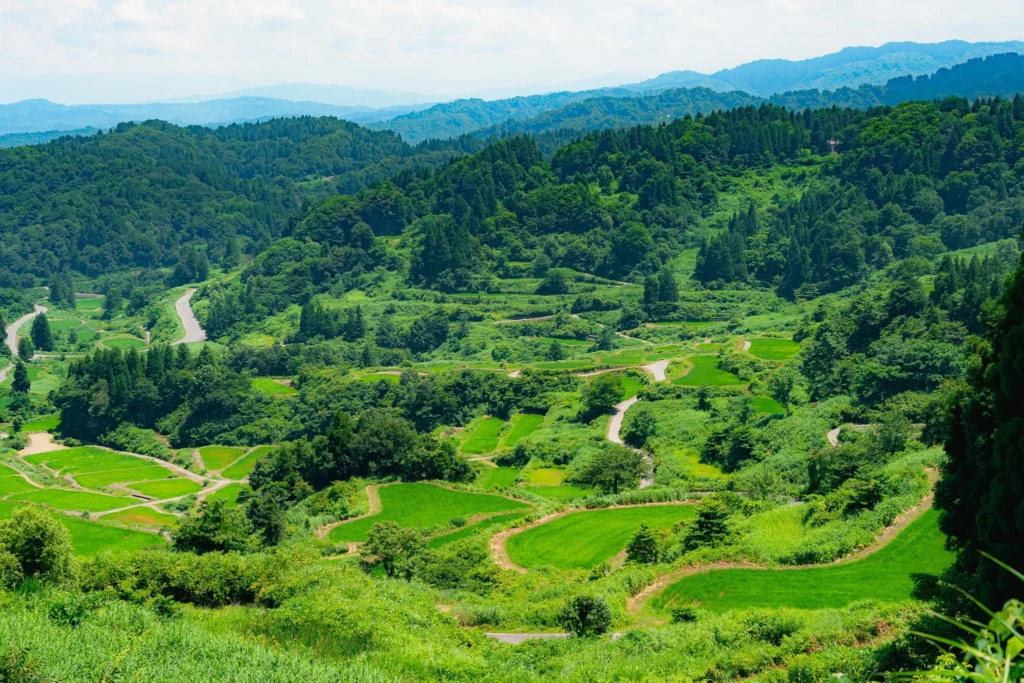
Soon, we reached the ridge, and the view suddenly opened up.
On the slopes lay about 200 terraced fields, layered like fish scales, stretching toward the ridges of the Echigo Sanzan mountains beyond. This is the Hoshitoge Terraced Rice Fields.
Yes—this is where Niigata’s famous white rice is grown. In spring and autumn, the fields reflect the sky like mirrors, and if you’re lucky, you might even catch a glimpse of a sea of clouds.
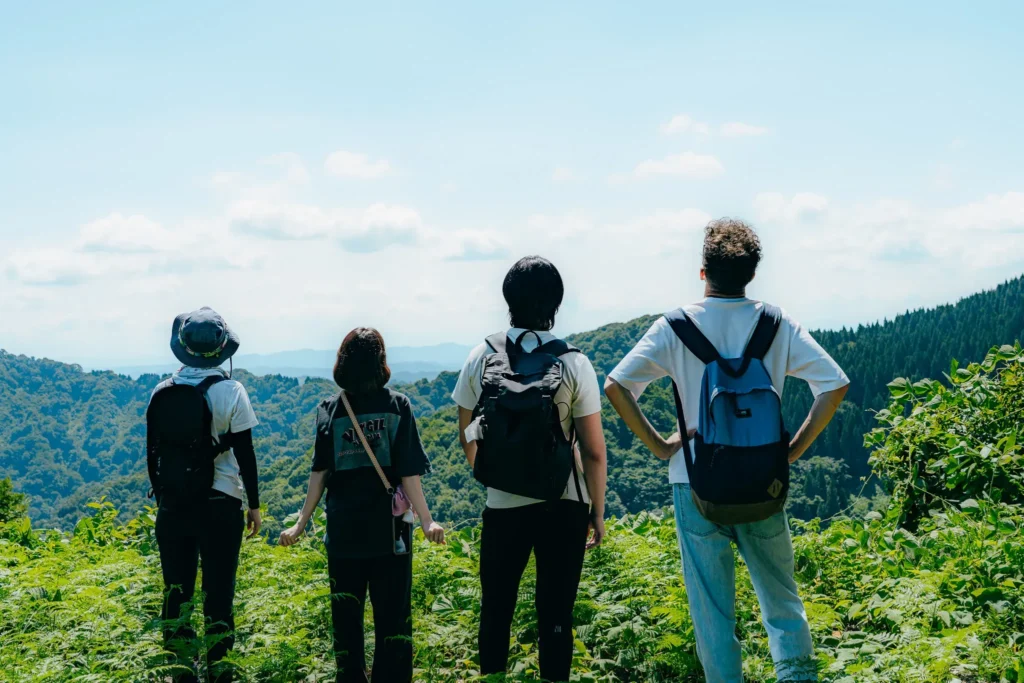
These terraced fields are not tourist attractions—they are privately owned and carefully maintained by local residents.
By staying on the paths, not taking anything, and carrying out your trash, you help preserve this landscape for the future. Visiting this place is more than sightseeing; it is a chance to connect with a way of life that has been lovingly preserved for generations.
→Read more about the trekking experience here
Kamosu no Mori — An Inn to Savor Sake and Fine Cuisine Amid the Forest’s Silence
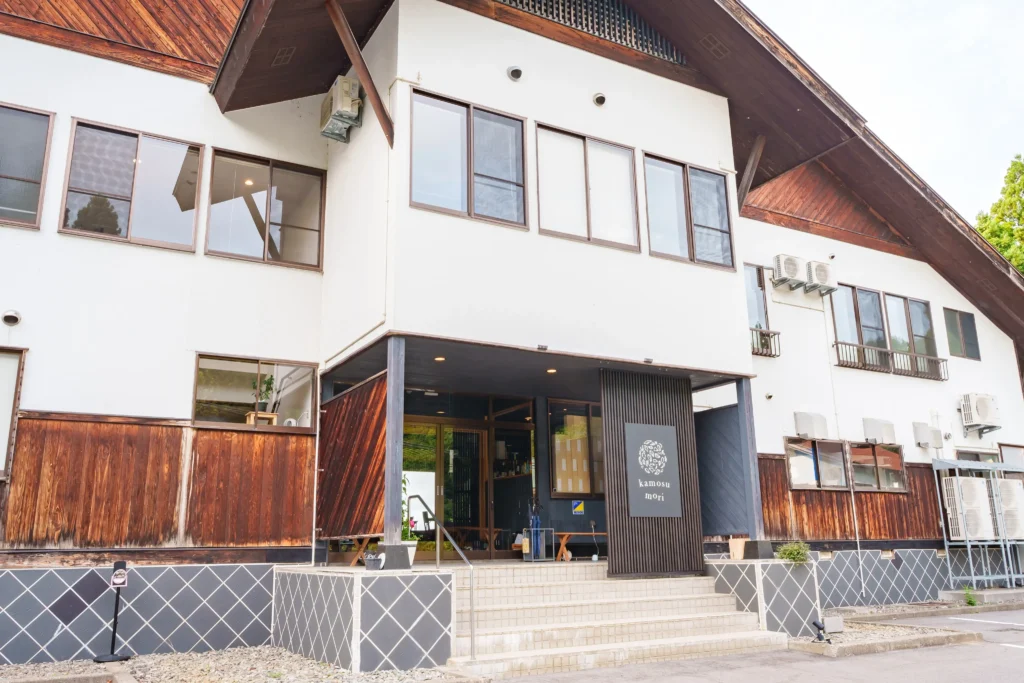
After finishing the trek and having lunch, it’s time to head to tonight’s accommodation.
A 30-minute drive along mountain roads brings you to a wooden inn that seems to blend seamlessly with the surrounding forest—this is Kamosu no Mori.
The name kamosu means “to ferment.” Just as rice and koji slowly mingle and mature over time, here, your mind gradually unwinds.Listening to the stillness of the forest, you’ll notice the pace of your journey naturally slowing down.
A Day Reserved for You — Luxurious Time Living with the Forest
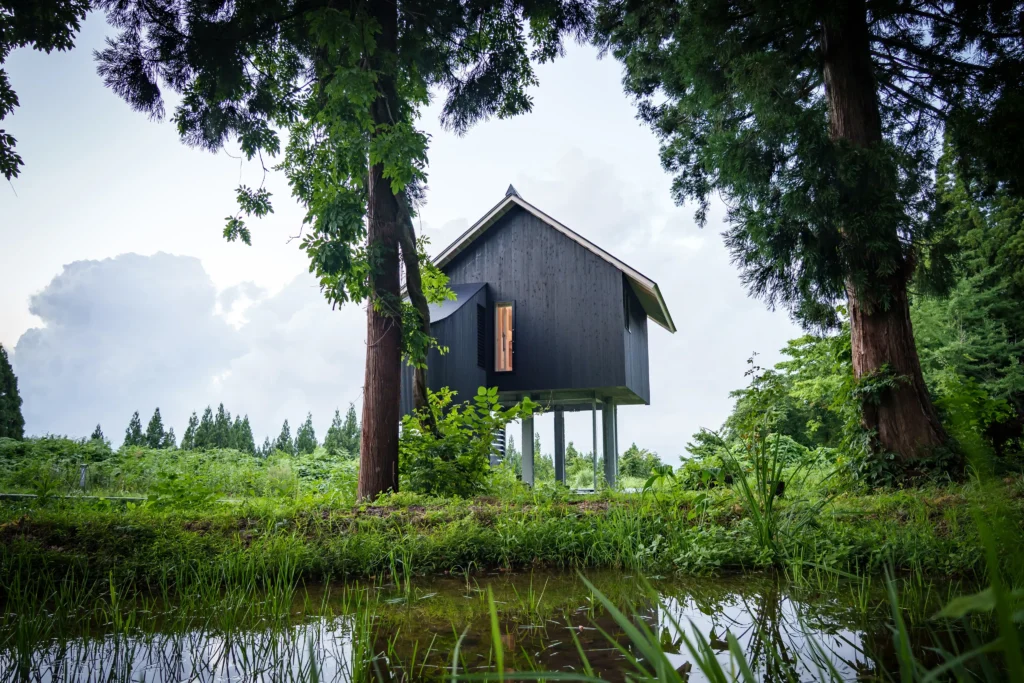
Kamosu no Mori offers several room types, but if possible, you should experience the private villa “Room V,” which opened in 2023.This special villa is reserved for just one group per day, offering a space as luxurious as a private retreat.
Set a short distance from the main building, the villa is surrounded by trees, and when you open the windows, all you hear is the wind and birdsong.The first floor features an outdoor space with sofas and a table, and during the right season, you can enjoy a BBQ or a campfire under the forest canopy.

The second floor serves as a living area and bedroom, decorated primarily in white.
It features a Simmons bed and wooden furniture that exude warmth—modern yet comforting in a familiar way.
Beyond the large windows, the forested ridges stretch gently, offering completely different views in the morning and at night.
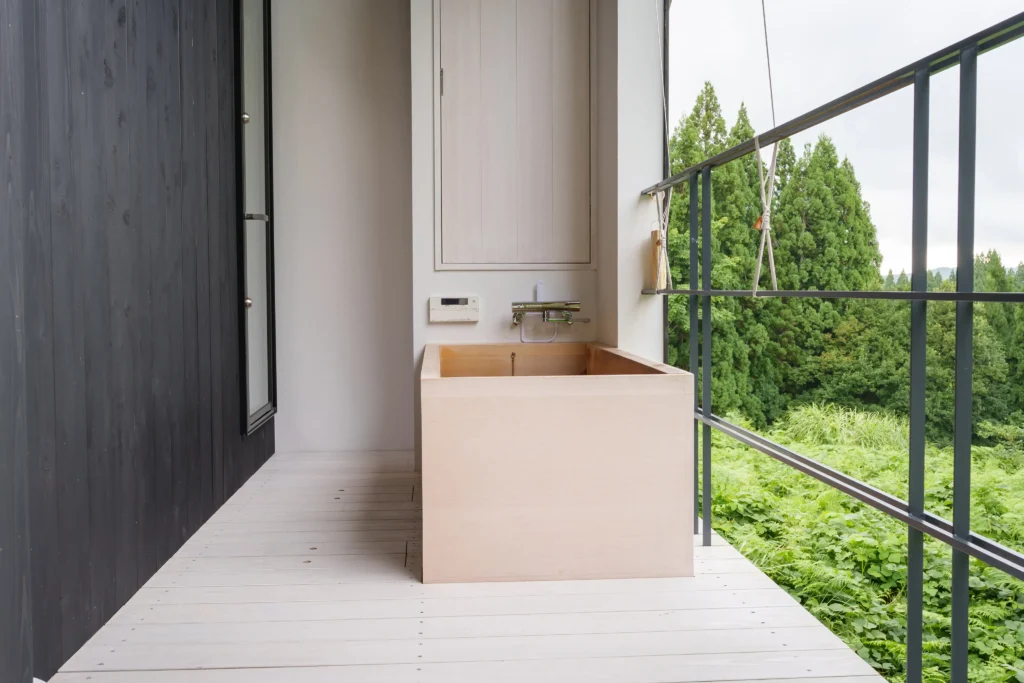
At the back of the living area is an open-air cypress bath.
The scent of hinoki drifts gently with the steam, relaxing your body from within.By night, you are surrounded by the starry sky; by morning, the sound of birds fills the air.
The changing light and sound throughout the day leave lasting memories of this special place.
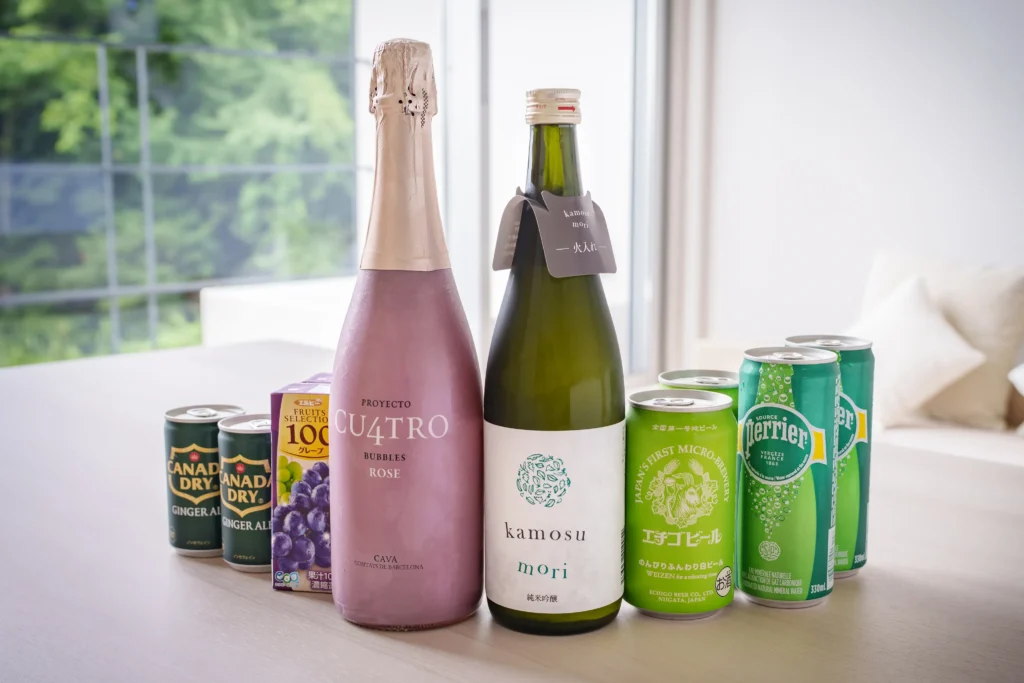
The fridge is stocked with craft beer, sake, wine, and local snacks—so well-equipped it hardly feels like a simple self-serve selection.The living area also features a large projector and screen, along with Bluetooth speakers.
You can play your favorite music while soaking in the open-air bath, glass in hand, gazing out over the forest. Here, the quiet of the surroundings becomes the ultimate luxury.
An Evening Feast — Where Sake and Italian Cuisine Harmonize
No account of Kamosu no Mori would be complete without mentioning its dinner experience.Here, the dishes and sake are carefully paired, each bringing out the best in the other.
The dining room is a calm space, with wood and glass as its primary materials.Glass cases resembling wine cellars display renowned sake from across Japan alongside craft bottles from Niigata.Candlelight flickers softly, blending with the forest’s quiet, creating a moment that feels both sacred and deeply comforting.
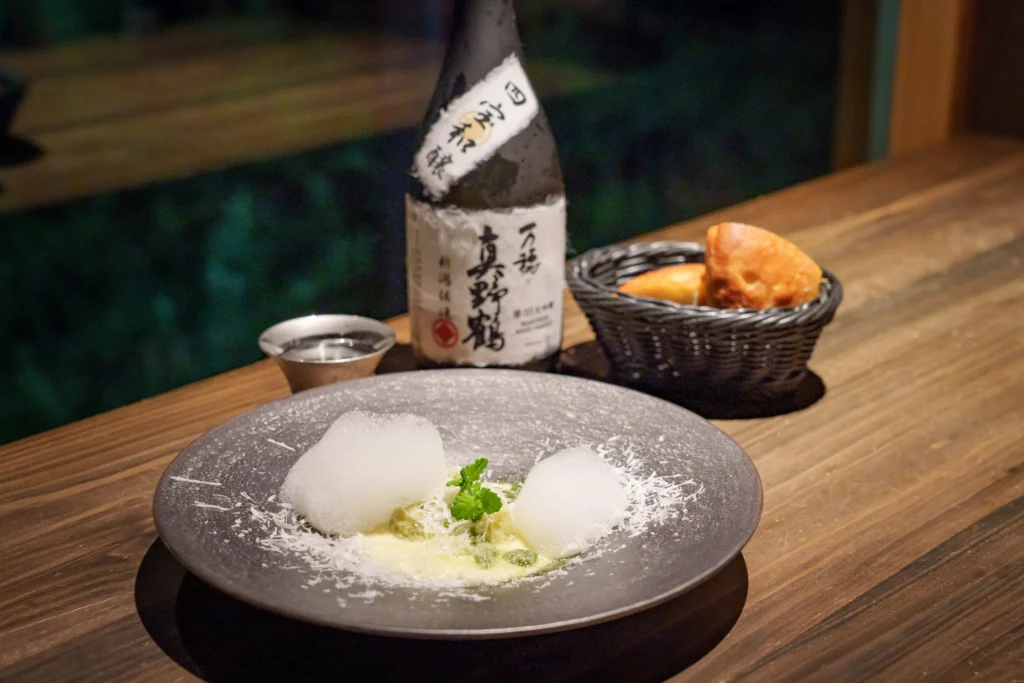
The course meal features creative Italian cuisine using ingredients from Niigata.
Snow-aged vegetables, wild mountain greens, locally sourced red meat, and Tokamachi Koshihikari rice flour—each dish embodies the blessings of the region’s four seasons.
What stood out most were the appetizer made with snow-aged carrots and the savory, perfectly roasted Niigata red meat.
The sake served with each dish complemented it as if it were part of the meal itself.
A fruit-scentedjunmai ginjo: Japanese sakeenhanced the sweetness of the vegetables, while the rich aroma of aged sake quietly enveloped the meat’s umami.

Pairing a different sake with every dish—
this delicate harmony of combinations is the true essence of dinner at Kamosu Mori.The sake never tries to dominate; instead, it resonates in the same breath as the food.In every glass, you can sense the creator’s sensibility overlapping with the chef’s intentions.
I don’t usually drink much sake, but on this night, I found myself completely captivated by its subtle world.
The chef’s refined movements, the manager’s thoughtful hospitality, and the stories infused into each sake.The candlelight swaying behind the glass,the darkness of the forest sinking beyond the window— all of it came together to leave a lingering, quiet afterglow on this night.
A moment to pause in the midst of a journey and allow oneself to ferment.Perhaps that is exactly the kind of time modern people need the most.
→ Read the full Kamosu Mori experience here

Yuichi Yamagishi, the owner of Kamosu Mori, also runs another renowned inn, “Tamakiy a—Sake Inn” in Matsunoyama Onsen.
As both a wine sommelier and a certified sake expert, Yamagishi has created a place celebrated nationwide for its Japanese sake pairing experience.
The philosophy of savoring sake, cuisine, and local culture as one flows consistently through both inns, shaping a truly immersive stay.
→ Read the full Tamakiya experience here
Day 3 | Discovering the Beauty of Tokamachi in Silence
Bijinbayashi — A Forest of a Hundred Years Telling a Story of Renewal

On the final day, after leaving Kamosu no Mori, we headed back toward Tokamachi Station with a slight detour to Bijinbayashi. This approximately 3-hectare beech forest in Matsunoyama, Niigata, has trees around 100 years old.
All the trees had once been cut down at the end of the Taisho period for charcoal, but the following spring, they sprouted all at once and regenerated. Knowing this story makes the straight, tall trunks appear even more dignified.
As sunlight filters through the leaves, the trunks emit a subtle sound.In spring, the mix of lingering snow and fresh leaves creates a serene scene; in summer, the cool air feels about two degrees colder than the surroundings; in autumn, golden and orange hues spread across the forest; in winter, the snow reflects the light, turning the landscape into a silver world. Each season transforms the forest into a living artwork.

If guided by a local expert, the forest’s story comes alive: the water cycle in snowy regions, the role of beech leaf litter, and the life of wild birds. Walking through, the sounds of the forest gradually merge with your own breathing, creating a sense of deep harmony.
Kiyotsu Gorge — A majestic canyon where the power of the earth meets light

Next came the highlight of the journey: Kiyotsu Gorge.
Alongside Kurobe Gorge and Osugidani, it is counted as one of Japan’s three great gorges. The steep V-shaped cliffs were formed by undersea volcanic activity some 15 million years ago, followed by uplift and erosion. Masses of hexagonal columnar joints loom overhead, while the emerald-green Kiyotsu River flows at their base— a landscape sculpted by the earth itself.
Today, visitors walk through the 750-meter Kiyotsu Gorge Tunnel, from which the gorge’s dramatic scenery can be viewed. Inside the tunnel are three lookout spaces, each with a unique artistic concept, turning the passageway itself into an immersive art environment.
Since its renovation as “Tunnel of Light” by Ma Yansong / MAD Architects for the 2018 Echigo-Tsumari Art Triennale, the site has drawn international attention.
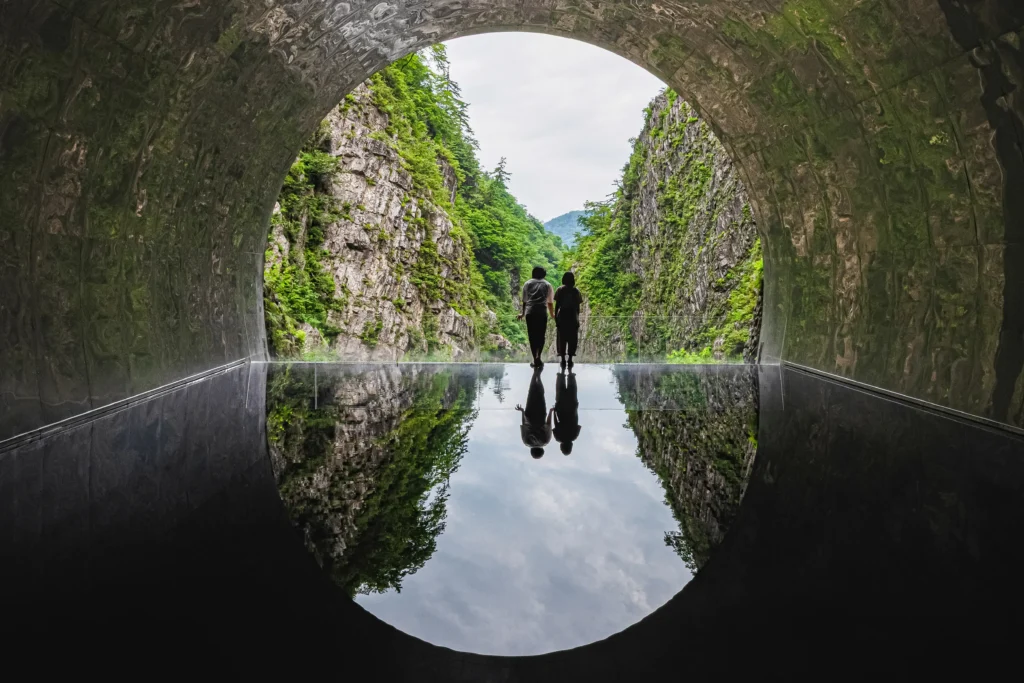
And finally, we reach the Panorama Station (Cave of Light).
The thin layer of water acts as a mirror, reflecting the canyon and sky, dissolving the boundary between above and below. Nature and art merge seamlessly, creating a breathtakingly beautiful scene. Although it can get crowded with photographers, visiting early in the morning allows for calmer water and softer gradations of light.

Upon exiting the tunnel, you’ll find a café, souvenir shops, and even a footbath. Warming your chilled feet, you can linger in the afterglow of the canyon.
This is a place where the raw power of nature resonates with human-made art. The beauty of Kiyotsu Gorge is something to be felt deep within, rather than just seen with the eyes.
Setsuryoan — A Quiet Gallery Café Nestled in the Mountains
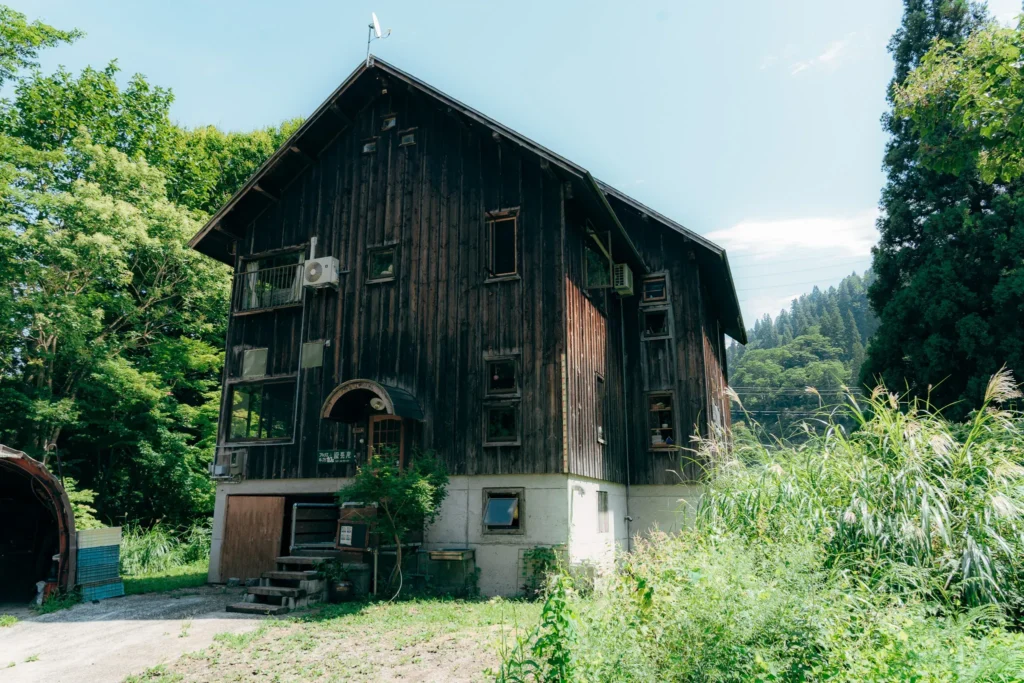
After leaving Kiyotsu Gorge, it’s about a 10-minute drive to Setsuryoan, a secluded wooden house quietly appearing amidst the mountain tranquility.
The house, built from reclaimed wood from an abandoned village, was transformed into a gallery-café by sculptor Noboru Kawanaka.
Originally from Hyogo, Kawanaka was drawn to this snow-covered region and has lived here for over a decade. Today, he continues his creative work in silence while warmly welcoming visitors.
The first floor serves as a café.The deeply roasted “Setsuryoan Blend” coffee offers a crisp, clean taste, made possible by the pure water of Tokamachi.
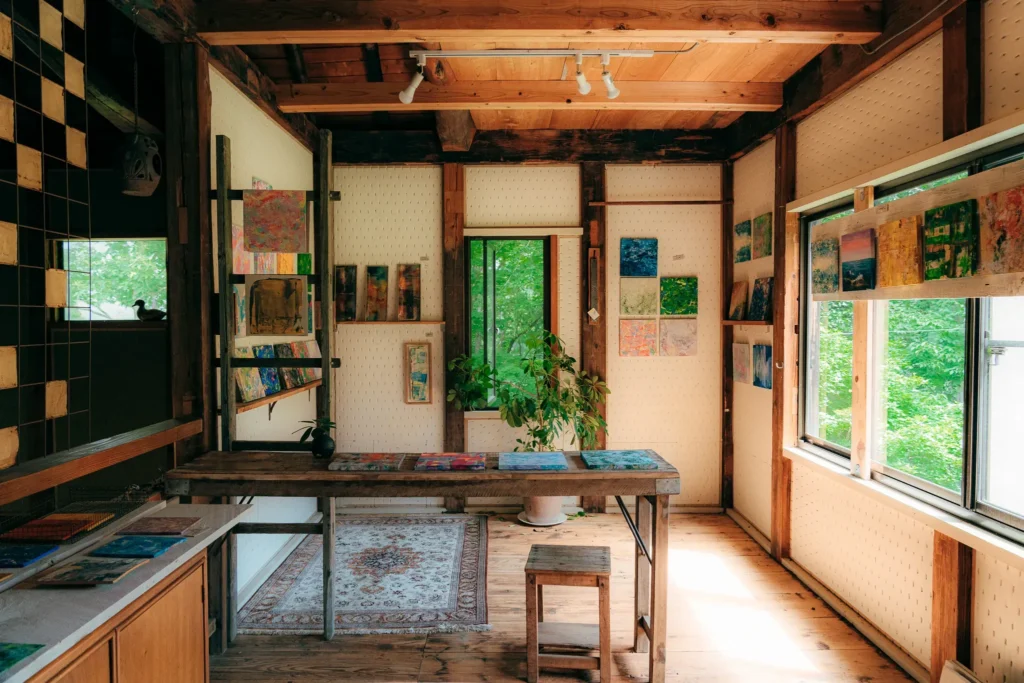
The second floor serves as the artist’s own studio and gallery.
Iron and wooden sculptures rest on the reclaimed wooden floors, accompanied by carefully selected chairs and cups—each piece exuding a quiet beauty born from the warmth of human hands and the passage of time.

The soft sound of analog records fills the space, mingling with the greenery outside the windows and the aroma of freshly brewed coffee.Spending time here slowly and unhurriedly offers a gentle, perfect conclusion to the journey.
Note: The inn operates on an irregular schedule, so please check in advance before visiting.
After a moment of rest at Setsuryoan, return to Tokamachi Station to drop off the rental car.
Throughout these three days—exploring art, walking through the satoyama, and staying in the forest—you’ll notice that every place you visit carries the mark of human hands and intentions.

The creativity alive in the Echigo-Tsumari Art Triennale, the wisdom of locals preserving the terraced rice fields, the restored old houses and the warm glow of inns—all of it comes together to form a single, living masterpiece: Tokamachi itself.
Just a few hours from Tokyo, snow melts, waters flow, greenery sprouts, and people live in harmony.
Within this gentle cycle, Tokamachi continues to breathe quietly today.
If you ever wish to step away from the daily hustle and experience a journey that touches true richness, Tokamachi will surely welcome you with quiet warmth.

